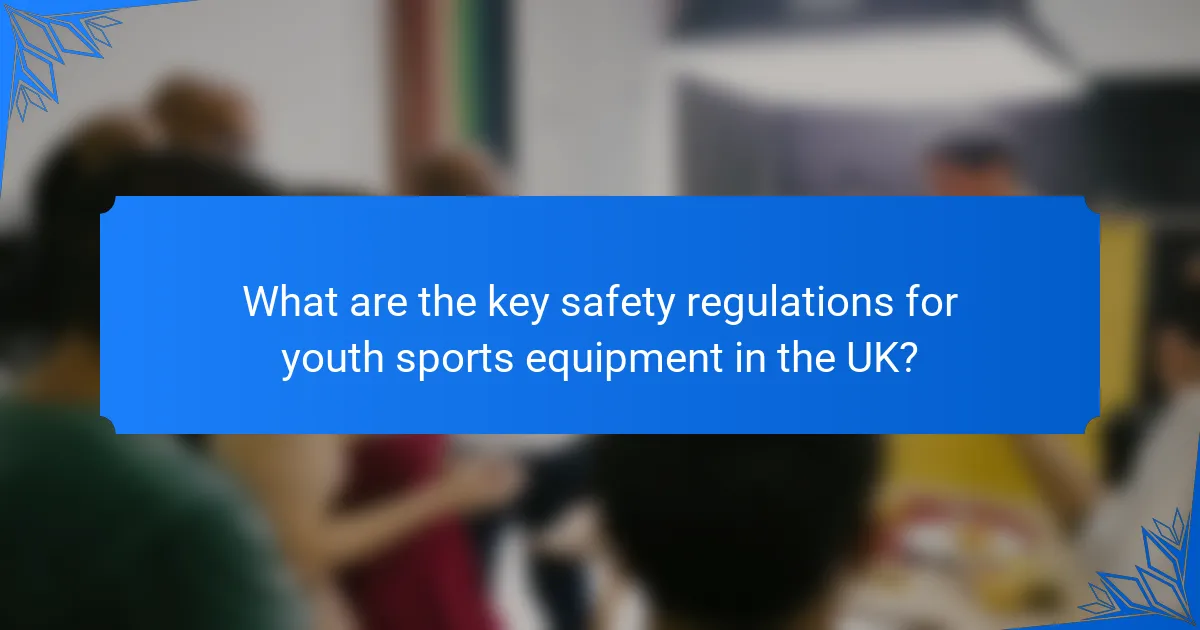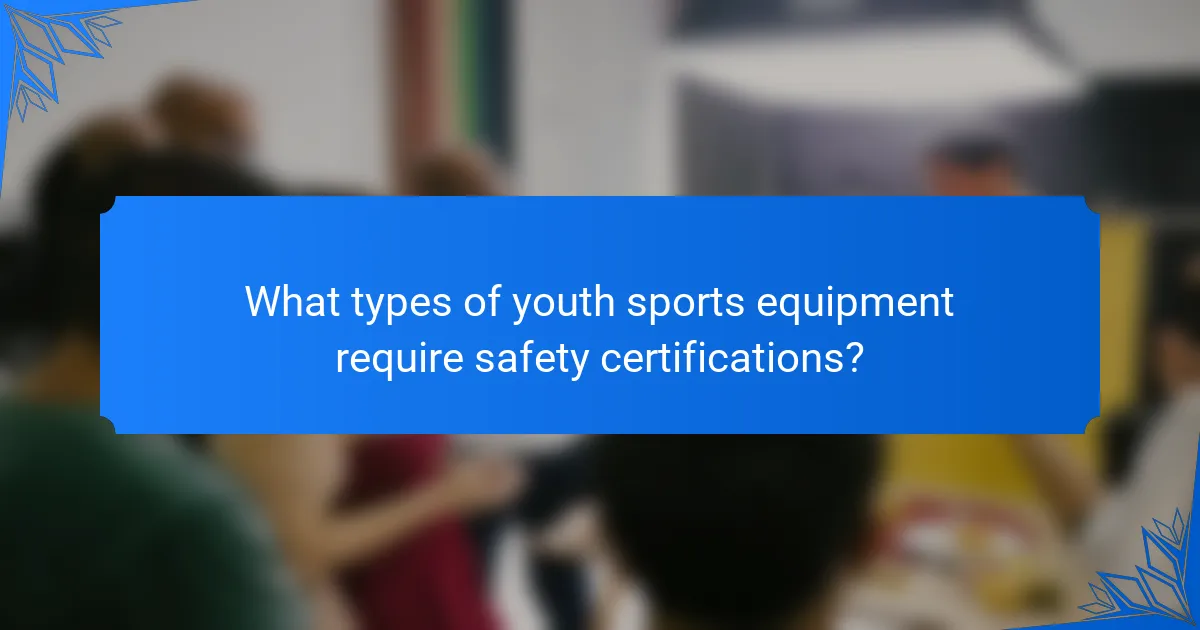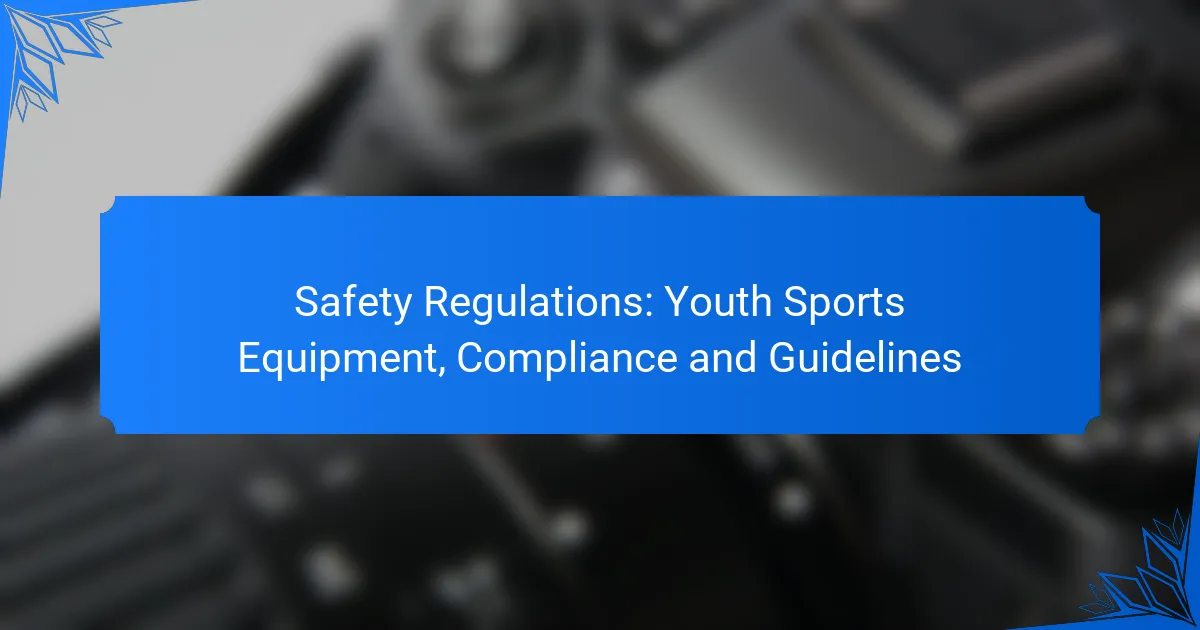Ensuring the safety of youth sports equipment is crucial for protecting young athletes from injury and promoting safe participation in sports. In the UK, regulations mandate that all equipment must be safe, suitable, and compliant with established standards. Organizations are responsible for regular inspections and maintaining documentation to ensure compliance, thereby minimizing risks associated with youth sports activities.

What are the key safety regulations for youth sports equipment in the UK?
The key safety regulations for youth sports equipment in the UK focus on ensuring that all equipment is safe, suitable, and compliant with established standards. These regulations aim to protect young athletes from injury and promote safe participation in sports activities.
British Standards Institution (BSI) guidelines
The British Standards Institution (BSI) provides comprehensive guidelines that set safety requirements for various types of youth sports equipment. These standards cover aspects such as material safety, design integrity, and performance requirements to minimize risks during use.
For example, equipment like football goals and playground apparatus must meet specific BSI standards to ensure they can withstand regular use without posing hazards. Regular inspections and maintenance are recommended to ensure ongoing compliance with these guidelines.
European Committee for Standardization (CEN) standards
The European Committee for Standardization (CEN) establishes standards that apply to youth sports equipment across Europe, including the UK. These standards ensure that equipment meets safety, health, and environmental protection requirements, promoting uniformity across member states.
CEN standards often include testing protocols to evaluate equipment durability and safety under various conditions. Compliance with these standards is crucial for manufacturers and organizations to ensure that their equipment is safe for young users.
Health and Safety Executive (HSE) recommendations
The Health and Safety Executive (HSE) offers recommendations that complement existing regulations by providing practical guidance on managing risks associated with youth sports equipment. These recommendations emphasize the importance of risk assessments and proper training for coaches and supervisors.
For instance, the HSE advises regular checks of equipment for wear and tear, ensuring that all safety features are functional. Organizations should also implement clear usage guidelines and provide appropriate supervision to enhance safety during sports activities.

How to ensure compliance with youth sports equipment regulations?
To ensure compliance with youth sports equipment regulations, organizations must regularly inspect their equipment and maintain thorough documentation of compliance procedures. This proactive approach minimizes risks and enhances the safety of young athletes.
Regular equipment inspections
Regular inspections of youth sports equipment are essential for identifying wear and tear that could compromise safety. Inspections should occur at the beginning of each season and periodically throughout, focusing on items like helmets, pads, and nets.
During inspections, look for signs of damage such as cracks, fraying, or rust. Establish a checklist to streamline the process, ensuring all equipment meets safety standards before use. For example, a checklist might include checking the integrity of straps, padding, and fasteners.
Documentation of compliance procedures
Documenting compliance procedures is crucial for tracking safety measures and ensuring accountability. This documentation should include records of inspections, maintenance performed, and any incidents related to equipment failure.
Maintain a centralized log that details the date of inspections, findings, and actions taken. This log not only helps in compliance with local regulations but also serves as a valuable resource for training new staff and addressing any safety concerns that arise.

What types of youth sports equipment require safety certifications?
Youth sports equipment that requires safety certifications primarily includes protective gear, sports balls, nets, and playing surfaces. These items must meet specific safety standards to ensure the well-being of young athletes during their activities.
Protective gear (helmets, pads)
Protective gear, such as helmets and pads, is essential for minimizing injury risks in youth sports. These items should comply with safety certifications from recognized organizations like the American Society for Testing and Materials (ASTM) or the National Operating Committee on Standards for Athletic Equipment (NOCSAE).
When selecting protective gear, look for labels indicating compliance with safety standards. Regularly inspect the equipment for wear and tear, and replace any damaged items to maintain safety during play.
Sports balls and nets
Sports balls and nets must also meet safety standards to ensure they are suitable for youth use. For example, soccer balls should be made of materials that reduce the risk of injury, while nets must be durable enough to withstand regular use without posing hazards.
Check for certifications from organizations like FIFA or the International Basketball Federation (FIBA) when purchasing sports balls. Ensure that nets are properly installed and maintained to prevent accidents during play.
Playing surfaces and goals
The playing surfaces and goals used in youth sports should adhere to safety regulations to prevent injuries. Surfaces should be designed to provide adequate shock absorption, and goals must be securely anchored to avoid tipping over.
Consider using materials that are specifically designed for youth sports, such as rubberized surfaces for playgrounds or synthetic turf for fields. Regular inspections and maintenance of these areas are crucial to ensure they remain safe for young athletes.

What are the consequences of non-compliance with safety regulations?
Non-compliance with safety regulations can lead to significant legal and financial repercussions for organizations involved in youth sports. These consequences often include legal liabilities, increased insurance costs, and a heightened risk of injuries among participants.
Legal liabilities for organizations
Organizations that fail to adhere to safety regulations may face lawsuits from injured parties or their families. Legal liabilities can result in costly settlements or judgments, which can financially strain even well-established organizations.
Additionally, non-compliance can lead to regulatory penalties, including fines imposed by local or national sports governing bodies. These penalties can vary widely, potentially reaching thousands of dollars depending on the severity of the violation.
Increased risk of injuries
Ignoring safety regulations significantly raises the likelihood of injuries among young athletes. Poorly maintained equipment or inadequate supervision can lead to accidents, resulting in anything from minor injuries to serious, long-term health issues.
Organizations should regularly inspect equipment and facilities to ensure compliance with safety standards. Implementing routine safety training for coaches and staff can also mitigate risks and promote a safer environment for youth sports participants.

How can organizations implement safety guidelines effectively?
Organizations can implement safety guidelines effectively by establishing clear protocols, providing proper training, and fostering a culture of safety among all participants. This approach ensures that everyone involved understands their responsibilities and the importance of adhering to safety measures.
Training programs for coaches and staff
Training programs for coaches and staff are essential for ensuring that safety guidelines are understood and followed. These programs should cover topics such as equipment usage, injury prevention, and emergency response procedures. Regular workshops and certifications can help keep staff updated on the latest safety practices.
Organizations should consider incorporating hands-on training sessions that simulate real-life scenarios. This practical approach allows coaches and staff to practice their responses to potential safety issues, enhancing their preparedness. Additionally, providing resources like manuals or online courses can reinforce learning.
Creating a safety culture within teams
Creating a safety culture within teams involves promoting open communication about safety concerns and encouraging team members to prioritize safety in all activities. Teams should hold regular meetings to discuss safety practices, review incidents, and share best practices. This fosters an environment where everyone feels responsible for maintaining safety.
Incentives can also motivate team members to adhere to safety guidelines. Recognizing individuals or teams that consistently follow safety protocols can reinforce positive behavior. Furthermore, involving athletes in safety discussions empowers them to take ownership of their well-being, leading to a more proactive approach to safety.

What are the best practices for maintaining youth sports equipment?
Maintaining youth sports equipment is crucial for safety and performance. Regular checks and proper care can extend the lifespan of gear and ensure that it functions correctly during use.
Routine maintenance schedules
Establishing a routine maintenance schedule is essential for keeping youth sports equipment in optimal condition. This schedule should include regular inspections, cleaning, and repairs based on usage frequency and manufacturer recommendations.
For example, equipment used daily may require weekly checks, while gear used less frequently can be inspected monthly. Documenting these maintenance activities can help track the condition and history of each item.
Proper storage techniques
Proper storage techniques significantly impact the longevity of youth sports equipment. Equipment should be stored in a cool, dry place to prevent moisture damage and deterioration from extreme temperatures.
Using racks, bins, or shelves can help keep items organized and accessible. Avoid stacking heavy items on top of lighter ones to prevent crushing and damage. Additionally, ensure that all equipment is clean and dry before storing to minimize the risk of mold and mildew.

What role do parents play in ensuring equipment safety?
Parents play a crucial role in ensuring the safety of youth sports equipment by actively monitoring its condition and advocating for proper maintenance. Their involvement helps prevent injuries and promotes a safe playing environment for young athletes.
Monitoring equipment condition
Regularly checking the condition of sports equipment is essential for safety. Parents should inspect items such as helmets, pads, and balls for signs of wear and tear, ensuring they meet safety standards before each use. Look for cracks, fraying, or any other damage that could compromise performance or safety.
Establish a routine for equipment checks, ideally before each practice or game. This can include a simple checklist: check for proper fit, look for visible damage, and ensure all components are functioning as intended. If any issues arise, address them immediately by repairing or replacing the equipment.
Additionally, parents should stay informed about the latest safety regulations and guidelines relevant to their child’s sport. Engaging with coaches and sports organizations can provide valuable insights into best practices for equipment maintenance and safety standards.
